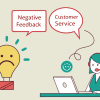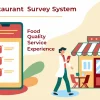
Restaurant Customer Feedback Loops: Building Loyalty
A restaurant customer feedback loop is vital for delivering excellent dining experiences. Gathering and utilizing restaurant customer feedback helps businesses enhance services and build lasting relationships with patrons.
What Is a Restaurant Customer Feedback Loop?
A restaurant customer feedback loop is a systematic process of collecting, analyzing, and acting on customer opinions. For restaurants, it ensures continuous improvement by integrating diners’ suggestions into daily operations.
Why Are Feedback Loops Important in Restaurants?
Restaurants thrive on customer satisfaction. A robust restaurant customer feedback loop helps:
1. Understanding Customer Preferences
Every diner has unique tastes and expectations. By collecting restaurant customer feedback, restaurants can identify common trends and individual preferences. For instance, customers might prefer healthier options, specific cuisines, or particular preparation styles.
Understanding these preferences allows restaurants to tailor their offerings, creating a more enjoyable dining experience.
2. Addressing Complaints Effectively
No restaurant is immune to occasional mistakes. Feedback loops provide a structured way to capture and address complaints. Whether it’s a delay in service or a dish that doesn’t meet expectations, quick and effective responses can turn negative experiences into opportunities for improvement. Customers appreciate when their concerns are acknowledged and resolved promptly.
3. Improving Menu Offerings and Service Quality
A restaurant customer feedback loop highlights areas for improvement in both food and service. For example, feedback might reveal:
- Dishes that need flavor adjustments.
- Portions that customers find too small or too large.
- Service delays during peak hours.
By acting on this information, restaurants can enhance the overall quality of their menu and service, ensuring a better experience for all diners.
4. Building Loyalty and Positive Word-of-Mouth
Satisfied customers are more likely to return and recommend the restaurant to others. A well-executed restaurant customer feedback loop shows patrons that their opinions matter. When changes are made based on customer input, it builds trust and strengthens the relationship between the restaurant and its guests.
This loyalty often translates into glowing reviews and recommendations, which are invaluable for attracting new customers.
Benefits of Restaurant Customer Feedback Loops
Feedback helps identify areas for improvement, enabling restaurants to address customer concerns and enhance overall services.
1. Enhancing Customer Satisfaction
Customer satisfaction is at the heart of any successful restaurant. By analyzing restaurant customer feedback loops, businesses can identify what diners truly value. This might include:
- Preferred Dishes and Flavors: Feedback helps chefs understand which dishes are favorites and why they resonate with customers. Adjustments can be made to enhance their appeal further.
- Service Speed and Staff Friendliness: Identifying delays in service or gaps in staff training allows for immediate improvements, ensuring customers feel well cared for during their visit.
When restaurants listen to their patrons, they create a more personalized and enjoyable dining experience, leading to higher customer retention and positive reviews.
2. Improving Menu and Service
Restaurant Customer Feedback loops empower restaurants to refine their menu and service quality. Chefs and managers can:
- Adjust Portion Sizes or Spice Levels: Addressing common requests such as larger portions or milder seasoning enhances customer satisfaction.
- Introduce New Dishes Based on Trends: Feedback reveals emerging preferences, allowing restaurants to stay relevant by updating their menu regularly.
For example, if customers consistently suggest adding more plant-based options, the restaurant can explore vegan or vegetarian dishes, broadening its appeal.
3. Building Strong Customer Relationships
When customers see that their opinions lead to real changes, they feel valued. This strengthens the bond between the restaurant and its patrons.
- Trust and Loyalty: Acting on feedback shows that the restaurant prioritizes its customers’ voices. Loyal customers are more likely to recommend the establishment to friends and family.
- Open Communication: Regular feedback loops create a channel for ongoing dialogue, encouraging repeat visits and fostering a sense of community.
4. Staying Competitive
The restaurant industry is highly competitive. Businesses that adapt to changing customer preferences gain an edge over their rivals.
- Tracking Evolving Tastes: Feedback helps identify shifts in diner expectations, such as preferences for healthier options or sustainable practices.
- Staying Ahead of Competitors: Restaurants that actively listen to their customers can innovate faster, ensuring they remain top-of-mind for diners.
By using customer feedback effectively, restaurants position themselves as responsive and customer-focused, key factors for long-term success.
Steps to Create a Restaurant Customer Feedback Loop
1. Collect Feedback Regularly
Feedback is the foundation of a feedback loop. Regularly collecting input ensures a continuous stream of actionable insights. Use tools like LazyMonkey to:
- Set Up Online Surveys: Online surveys are a convenient way for diners to share their thoughts at their leisure. Ensure the surveys are short and focused to maximize responses.
- Distribute Comment Cards: Physical comment cards placed at tables or counters encourage immediate feedback. This method works well for customers who prefer pen-and-paper methods.
- Monitor Reviews on Platforms: Regularly check platforms like Google, Yelp, and TripAdvisor for customer reviews. These reviews often contain honest and detailed opinions about dining experiences.
2. Categorize Feedback
Once feedback is collected, organize it into manageable categories to make analysis easier. Common categories include:
- Food Quality: Are dishes meeting expectations for taste and presentation?
- Service Speed: Are orders being taken and delivered promptly?
- Ambiance and Cleanliness: Is the environment clean and inviting?
Categorization helps prioritize areas that need immediate attention, streamlining the improvement process.
3. Analyze Data
Data analysis is crucial for identifying patterns and recurring themes in customer feedback. For instance:
- Recurring Complaints: Are multiple customers pointing out the same issue, such as slow service or underseasoned food?
- Praised Menu Items: Which dishes receive the most compliments? Understanding what works can help refine the menu further.
Using tools like LazyMonkey can simplify data analysis by generating insights from raw feedback quickly and efficiently.
4. Take Action
Feedback is only valuable if it leads to meaningful changes. Translate insights into specific actions, such as:
- Updating Recipes: Adjusting flavors, portion sizes, or ingredients based on customer preferences.
- Training Staff: Addressing service issues by providing additional training for servers or kitchen staff.
Implementing these changes shows customers that their opinions matter and builds trust in the restaurant’s commitment to improvement.
5. Close the Loop
Closing the restaurant customer feedback loop means informing customers about the changes made based on their input. This can be done through:
- Social Media Updates: Share posts about new menu items or service improvements inspired by customer feedback.
- Direct Communication: Reach out to frequent reviewers or survey participants to thank them and explain the impact of their feedback.
Showing customers that their voices lead to real changes encourages ongoing participation and builds loyalty.
Tools to Gather Restaurant Feedback
1. Online Surveys
Online platforms make creating and distributing online surveys simple and customizable. These surveys can be sent via email, SMS, or QR codes on receipts, making it easy for customers to share their thoughts.
2. Review Monitoring Tools
Review monitoring tools help track feedback on popular platforms like Google and Yelp. These tools notify restaurants of new reviews, making it easier to respond promptly and address any concerns raised.
3. Point-of-Sale (POS) Systems
Modern POS systems often include built-in feedback collection features. These systems can prompt customers to leave feedback immediately after completing their transaction, capturing impressions while they’re still fresh.
4. In-Person Feedback
Encourage staff to engage with customers during their visit. For example:
- Ask Questions: Servers can ask diners about their experience before they leave.
- Provide Comment Cards: Physical cards allow diners to share thoughts privately and immediately.
LazyMonkey offers all the features that are required in an online survey tool. To know more, you can book a demo.
Challenges in Managing Feedback Loops
Managing customer feedback loops effectively can be a complex process, with several challenges that restaurant owners and managers often face. These challenges can hinder the ability to collect meaningful insights and act on them effectively. Below are the main obstacles:
Challenges
- Low Response Rates:
- Many customers are unwilling or uninterested in taking the time to fill out surveys, write reviews, or engage with feedback systems. This results in a limited pool of data that might not fully represent the customer base.
- Bias in Responses:
- Feedback is often provided by customers who are either extremely satisfied or very dissatisfied, which can lead to skewed results. This bias may not reflect the overall customer experience accurately.
- Time Constraints:
- Restaurant staff, especially in busy establishments, may find it difficult to allocate sufficient time to collect, process, and analyze feedback. Balancing these tasks with daily operations can be challenging.
Solutions in Managing Feedback Loops
Use automation tools to streamline the feedback process. These platforms can collect, analyze, and organize feedback through digital channels such as email, text messages, or mobile apps, saving time and ensuring consistency.
1. Incentivize Participation with Discounts or Freebies:
To address low response rates, offer incentives such as discounts on a future visit, free appetizers, or small gifts. This creates extra motivation for customers to provide feedback.
2. Design Neutral, Unbiased Surveys:
Develop surveys that are neutral in tone and cover a wide range of customer experience aspects. Questions should avoid leading customers toward particular answers, ensuring more accurate and balanced feedback.
3. Automate Feedback Collection and Analysis with Tools
Use automation tools to streamline the feedback process. These platforms can collect, analyze, and organize feedback through digital channels such as email, text messages, or mobile apps, saving time and ensuring consistency.
Conclusion
A restaurant customer feedback loop is essential for improving dining experiences and staying competitive. By using tools restaurants can streamline feedback collection, make data-driven improvements, and show customers they value their opinions. Integrating feedback into everyday operations ensures long-term success in the ever-evolving food industry.
Frequently Asked Questions? (FAQs)
How Can LazyMonkey Help With Restaurant Customer Feedback Loops?
LazyMonkey simplifies survey creation, feedback collection, and data analysis.
How Can Restaurants Encourage More Feedback?
Incentivize feedback with discounts, free items, or loyalty rewards.
Can I Suggest New Menu Items?
Absolutely! We love receiving suggestions from our guests. Feel free to share any ideas you have for new dishes or drinks.
Is My Feedback Confidential?
Yes, all restaurant customer feedback is treated confidentially. We only use it to improve our services and may reach out to you for clarification or follow-up.
Enhance Patient Care and NABH Compliance with LazyMonkey
LazyMonkey is your all-in-one solution for improving patient care, retaining more patients, and meeting NABH standards. Our powerful QR-based feedback tool enables you to capture real-time insights from patient feedback, discharge surveys, staff and doctor evaluations, and clinical research, while also streamlining inter-departmental communication.
Transform your healthcare facility today - reach out to us at hello@lazymonkey.in, or request a demo here!
Elevate Your Restaurant Experience with LazyMonkey
LazyMonkey’s QR-based feedback system helps you gather real-time insights from customers, track satisfaction levels, and enhance the dining experience. Get instant feedback on your menu, service, and ambience, and make data-driven improvements to boost repeat customers and reviews.
Improve your restaurant today – reach out to us at hello@lazymonkey.in, or request a demo here!
Empower Student Engagement and Campus Improvement with LazyMonkey
LazyMonkey offers a seamless way to gather student feedback, track satisfaction, and enhance campus life. From course evaluations to dorm feedback, our QR-based solution makes it easy to capture valuable insights and improve student retention.
Upgrade your university experience – contact us at hello@lazymonkey.in, or request a demo here!
Streamline Feedback and Drive Performance Across Your Enterprise/Franchise with LazyMonkey
Whether you manage one or multiple locations, LazyMonkey’s QR-based feedback system helps you gather real-time employee and customer feedback. Improve operational efficiency, track satisfaction, and make data-driven decisions to enhance brand consistency and growth.
Transform your franchise today – reach out to us at hello@lazymonkey.in, or request a demo here!
Enhance Customer Satisfaction and Service Standards in Banking with LazyMonkey
LazyMonkey empowers banks to capture real-time feedback from clients across branches. Improve customer experience, assess service quality, and ensure regulatory compliance with our QR-based solution, helping you retain clients and meet banking standards.
Elevate your bank’s customer care – contact us at hello@lazymonkey.in, or request a demo here!
Boost Customer Engagement and Mall Satisfaction with LazyMonkey
LazyMonkey’s QR-based feedback tool enables you to collect feedback from shoppers, track satisfaction, and enhance the mall experience. Gather insights on store services, cleanliness, and entertainment to create an unmatched customer journey.














